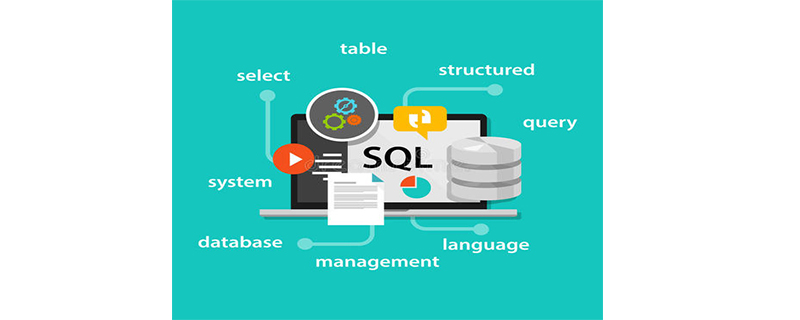What parts does sql language include?
SQL language includes: 1. "DQL" data query language; 2. "DML" data manipulation language; 3. "TPL" transaction processing language; 4. "DCL" data control language; 5 , "DDL" data definition language; 6. "CCL" pointer control language, etc.

sql language includes: data query language, data operation language, transaction processing language, data control language, data definition language and pointer control language

1. Data Query Language (DQL)
Its statements, also called "data retrieval statements", are used to obtain data from tables. Determine how data is presented in the application. The reserved word SELECT is the most commonly used verb in DQL (and all SQL). Other commonly used reserved words in DQL include WHERE, ORDER BY, GROUP BY and HAVING. These DQL reserved words are often used with other types of SQL statements.
2. Data Manipulation Language (DML)
Its statements include INSERT, UPDATE and DELETE. Used to add, modify and delete records in the table respectively. Also known as Action Query Language.
3. Transaction Processing Language (TPL)
Its statements can ensure that all rows of the table affected by the DML statement are updated in a timely manner. TPL statements include BEGIN TRANSACTION, COMMIT and ROLLBACK.
4. Data Control Language (DCL)
Its statements are licensed through GRANT or REVOKE to determine the access of individual users and user groups to database objects. . Some RDBMS can use GRANT or REVOKE to control access to individual columns of a table.
5. Data Definition Language (DDL)
Its statements include the verbs CREATE, DROP, and ALTER. Create a new table or delete a table in the database (CREATE TABLE or DROP TABLE or ALTER TABLE); operate the structure of the table and add indexes to the table.
6. Pointer Control Language (CCL)
Its statements, such as DECLARE CURSOR, FETCH INTO and UPDATE WHERE CURRENT are used to manipulate individual rows of one or more tables ( record) operations.
The above is the detailed content of What parts does sql language include?. For more information, please follow other related articles on the PHP Chinese website!

Hot AI Tools

Undresser.AI Undress
AI-powered app for creating realistic nude photos

AI Clothes Remover
Online AI tool for removing clothes from photos.

Undress AI Tool
Undress images for free

Clothoff.io
AI clothes remover

AI Hentai Generator
Generate AI Hentai for free.

Hot Article

Hot Tools

Notepad++7.3.1
Easy-to-use and free code editor

SublimeText3 Chinese version
Chinese version, very easy to use

Zend Studio 13.0.1
Powerful PHP integrated development environment

Dreamweaver CS6
Visual web development tools

SublimeText3 Mac version
God-level code editing software (SublimeText3)

Hot Topics
 1371
1371
 52
52
 How do you alter a table in MySQL using the ALTER TABLE statement?
Mar 19, 2025 pm 03:51 PM
How do you alter a table in MySQL using the ALTER TABLE statement?
Mar 19, 2025 pm 03:51 PM
The article discusses using MySQL's ALTER TABLE statement to modify tables, including adding/dropping columns, renaming tables/columns, and changing column data types.
 How do I configure SSL/TLS encryption for MySQL connections?
Mar 18, 2025 pm 12:01 PM
How do I configure SSL/TLS encryption for MySQL connections?
Mar 18, 2025 pm 12:01 PM
Article discusses configuring SSL/TLS encryption for MySQL, including certificate generation and verification. Main issue is using self-signed certificates' security implications.[Character count: 159]
 How do you handle large datasets in MySQL?
Mar 21, 2025 pm 12:15 PM
How do you handle large datasets in MySQL?
Mar 21, 2025 pm 12:15 PM
Article discusses strategies for handling large datasets in MySQL, including partitioning, sharding, indexing, and query optimization.
 What are some popular MySQL GUI tools (e.g., MySQL Workbench, phpMyAdmin)?
Mar 21, 2025 pm 06:28 PM
What are some popular MySQL GUI tools (e.g., MySQL Workbench, phpMyAdmin)?
Mar 21, 2025 pm 06:28 PM
Article discusses popular MySQL GUI tools like MySQL Workbench and phpMyAdmin, comparing their features and suitability for beginners and advanced users.[159 characters]
 How do you drop a table in MySQL using the DROP TABLE statement?
Mar 19, 2025 pm 03:52 PM
How do you drop a table in MySQL using the DROP TABLE statement?
Mar 19, 2025 pm 03:52 PM
The article discusses dropping tables in MySQL using the DROP TABLE statement, emphasizing precautions and risks. It highlights that the action is irreversible without backups, detailing recovery methods and potential production environment hazards.
 How do you represent relationships using foreign keys?
Mar 19, 2025 pm 03:48 PM
How do you represent relationships using foreign keys?
Mar 19, 2025 pm 03:48 PM
Article discusses using foreign keys to represent relationships in databases, focusing on best practices, data integrity, and common pitfalls to avoid.
 How do you create indexes on JSON columns?
Mar 21, 2025 pm 12:13 PM
How do you create indexes on JSON columns?
Mar 21, 2025 pm 12:13 PM
The article discusses creating indexes on JSON columns in various databases like PostgreSQL, MySQL, and MongoDB to enhance query performance. It explains the syntax and benefits of indexing specific JSON paths, and lists supported database systems.
 How do I secure MySQL against common vulnerabilities (SQL injection, brute-force attacks)?
Mar 18, 2025 pm 12:00 PM
How do I secure MySQL against common vulnerabilities (SQL injection, brute-force attacks)?
Mar 18, 2025 pm 12:00 PM
Article discusses securing MySQL against SQL injection and brute-force attacks using prepared statements, input validation, and strong password policies.(159 characters)




